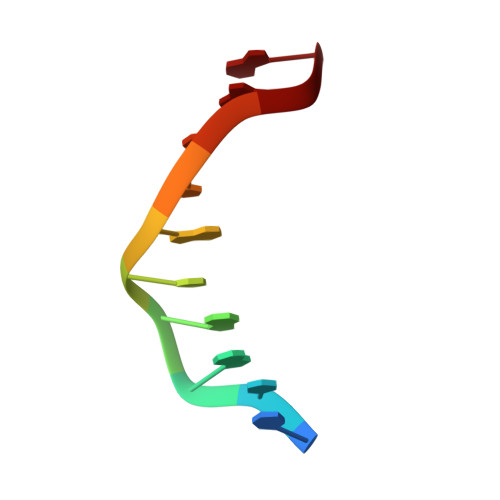1 A crystal structures of B-DNA reveal sequence-specific binding and groove-specific bending of DNA by magnesium and calcium.
Chiu, T.K., Dickerson, R.E.(2000) J Mol Biol 301: 915-945
- PubMed: 10966796
- DOI: https://doi.org/10.1006/jmbi.2000.4012
- Primary Citation of Related Structures:
1EN3, 1EN8, 1EN9, 1ENE - PubMed Abstract:
The 1 A resolution X-ray crystal structures of Mg(2+) and Ca(2+) salts of the B-DNA decamers CCAACGTTGG and CCAGCGCTGG reveal sequence-specific binding of Mg(2+) and Ca(2+) to the major and minor grooves of DNA, as well as non-specific binding to backbone phosphate oxygen atoms. Minor groove binding involves H-bond interactions between cross-strand DNA base atoms of adjacent base-pairs and the cations' water ligands. In the major groove the cations' water ligands can interact through H-bonds with O and N atoms from either one base or adjacent bases, and in addition the softer Ca(2+) can form polar covalent bonds bridging adjacent N7 and O6 atoms at GG bases. For reasons outlined earlier, localized monovalent cations are neither expected nor found.Ultra-high atomic resolution gives an unprecedented view of hydration in both grooves of DNA, permits an analysis of individual anisotropic displacement parameters, and reveals up to 22 divalent cations per DNA duplex. Each DNA helix is quite anisotropic, and alternate conformations, with motion in the direction of opening and closing the minor groove, are observed for the sugar-phosphate backbone. Taking into consideration the variability of experimental parameters and crystal packing environments among these four helices, and 24 other Mg(2+) and Ca(2+) bound B-DNA structures, we conclude that sequence-specific and strand-specific binding of Mg(2+) and Ca(2+) to the major groove causes DNA bending by base-roll compression towards the major groove, while sequence-specific binding of Mg(2+) and Ca(2+) in the minor groove has a negligible effect on helix curvature. The minor groove opens and closes to accommodate Mg(2+) and Ca(2+) without the necessity for significant bending of the overall helix. The program Shelxdna was written to facilitate refinement and analysis of X-ray crystal structures by Shelxl-97 and to plot and analyze one or more Curves and Freehelix output files.
Organizational Affiliation:
Molecular Biology Institute and Department of Chemistry and Biochemistry, University of California, Los Angeles, CA 90095-1570, USA.















